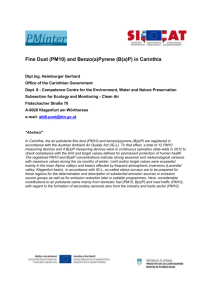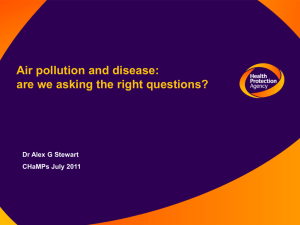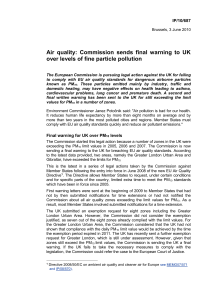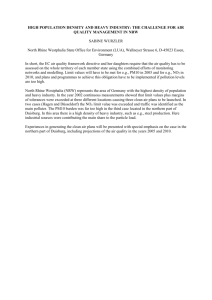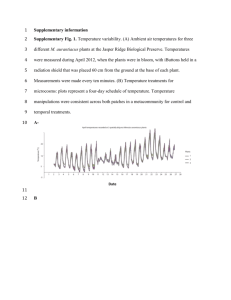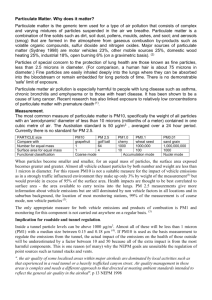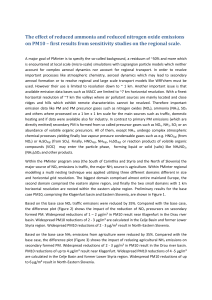Word - 373 KB - Department of the Environment
advertisement
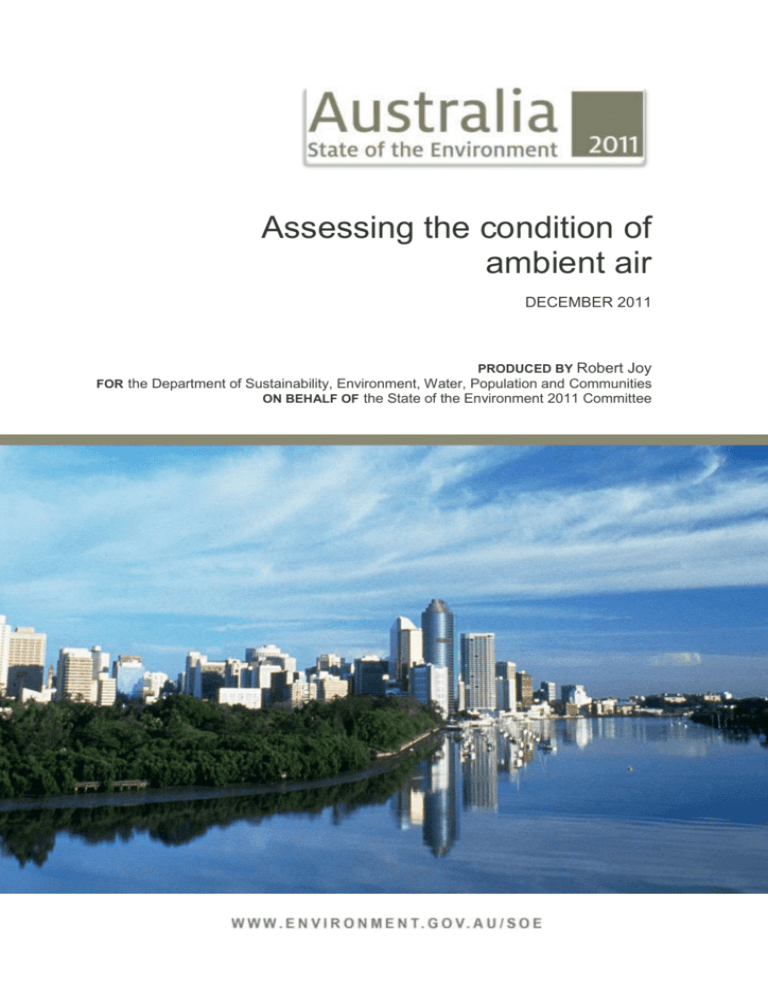
Assessing the condition of ambient air DECEMBER 2011 PRODUCED BY Robert Joy DECEMBER 2011 FOR the Department of Sustainability, Environment, Water, Population and Communities ON BEHALF OF the State of the Environment 2011 Committee Citation Joy R, Assessing the condition of ambient air. Report prepared for the Australian Government Department of Sustainability, Environment, Water, Population and Communities on behalf of the State of the Environment 2011 Committee. Canberra: DSEWPaC, 2011. © Commonwealth of Australia 2011 This work is copyright. Apart from any use as permitted under the Copyright Act 1968, no part may be reproduced by any process without prior written permission from the Commonwealth. Requests and enquiries concerning reproduction and rights should be addressed to Department of Sustainability, Environment, Water, Populations and Communities, Public Affairs, GPO Box 787 Canberra ACT 2601 or email public.affairs@environment.gov.au Disclaimer The views and opinions expressed in this publication are those of the author and do not necessarily reflect those of the Australian Government or the Minister for Sustainability, Environment, Water, Population and Communities. While reasonable efforts have been made to ensure that the contents of this publication are factually correct, the Commonwealth does not accept responsibility for the accuracy or completeness of the contents, and shall not be liable for any loss or damage that may be occasioned directly or indirectly through the use of, or reliance on, the contents of this publication. Cover image Brisbane skyline, QLD Photo by Paradise Ink & DSEWPaC Australia ■ State of the Environment 2011 Supplementary information i Preface This report was developed by the author as part of the Atmosphere chapter of the Australia State of the Environment (SoE) 2011 report. It was removed from the main report due to limitations of space and is presented here as supplementary information. The Minister for Environment is required, under the Environment Protection and Biodiversity Conservation Act 1999, to table a report in Parliament every five years on the State of the Environment. The Australia State of the Environment (SoE) 2011 report is a substantive, hardcopy report compiled by an independent committee appointed by the Minister for Environment. The report is an assessment of the current condition of the Australian environment, the pressures on it and the drivers of those pressures. It details management initiatives in place to address environmental concerns and the effectiveness of those initiatives. The main purpose of SoE 2011 is to provide relevant and useful information on environmental issues to the public and decision-makers, in order to raise awareness and support more informed environmental management decisions that lead to more sustainable use and effective conservation of environmental assets. The 2011 SoE report, commissioned technical reports and other supplementary products are available online at www.environment.gov.au/soe Australia ■ State of the Environment 2011 Supplementary information ii Assessing the condition of ambient air List of Figures Figure 1 Capital Cities - Air Quality Index - Percentage Frequency Distributions – Ozone (4 hour NEPM Standard).......................................................................... 4-6 Figure 2 Capital Cities - Air Quality Index - Percentage Frequency Distributions – Particles (PM10 24 hour NEPM Standard)........................................................ 7-10 Figure 3 Regional Cities - Air Quality Index - Percentage Frequency Distributions – Ozone (4 hour NEPM Standard)........................................................................... 11 Figure 4 Regional Cities - Air Quality Index - Percentage Frequency Distributions – Particles (PM10 24 hour NEPM Standard)...................................................... 12-14 Australia ■ State of the Environment 2011 Supplementary information 1 Assessing the condition of ambient air Applying a Graded Report Card Approach to Australia’s Urban Air Quality As part of the State of the Environment reporting process, a qualitative assessment was made of ambient air quality in the eight state and territory capitals and in a small number of major regional or industrial centres. The results of that assessment (generalised across periods of up to 11 years ) are set out in Assessment Summaries 3.4 – 3.7 in the Atmosphere Chapter of the 2011 Report. The assessments were based on analysis of air quality monitoring data for ozone and particles (PM10) collected in accordance with protocols under the National Environment Protection (Ambient Air Quality) Measure (NEPM(AAQ)). These data were transformed into an Air Quality Index (AQI) that related directly to the health-based standards in the NEPM (AAQ). Five qualitative AQI categories are used in public reporting of air quality. Very Poor 150+ Poor 100– 149 Fair 67–99 Good 34–66 Very Good 0–33 Air quality is unhealthy and everyone may begin to experience health effects. People from sensitive groups may experience more serious health effects. Air quality is unhealthy for sensitive groups. The general population is not likely to be affected in this range. Air quality is acceptable. However, there may be a health concern for very sensitive people. Air quality is considered good, and air pollution poses little or no risk. Air quality is considered very good and air pollution poses little or no risk. Source: Department of Sustainability, Environment, Water, Population and Communities, 2011: State of the Air in Australia 1999-2008 These categories were used as the framework for assessing each cities’ air quality (in terms of ozone and particles). (repeated from Box 3.9, Atmosphere chapter, SoE 2011) Australia ■ State of the Environment 2011 Supplementary information 2 Assessing the condition of ambient air The assessment approach based the characterisation of an airshed on its worst performing monitoring station, rather than the total number of exceedences across the airshed, since this is strongly influenced by the number of monitoring stations. Only data from monitoring stations established in accordance with an approved NEPM monitoring plan were considered. (In some cases, less than 10 years of NEPM monitoring data were available, and in one case – Perth - 11 years of data were available.) Most large regional cities have only one NEPM monitoring station, and most monitor particles but not ozone, since they lack the scale of industry and traffic likely to give rise to ozone as a secondary pollutant. In each state the regional cities selected for analysis of PM10 and ozone (where this was monitored) were the worst performing in the state. It is recognised that the 10-year goals set in the Ambient Air Quality NEPM for ozone and particles allow for one exceedence per year for ozone and five exceedences per year for particles. Nevertheless, given the nature of thehealth-based standards, andy exceedence may have a potentially adverse impact and should therefore be taken into consideration, even if the goal is met. Ozone levels were calculated against the four-hour exposure standard rather than the onehour, as the four-hour standard is more likely to give a better indication of the impact on the general population, rather than on sensitive individuals who are likely to be affected by acute (i.e. shorter term) events. Procedure For each year, monitoring data for ozone and PM10 from each of the selected stations were converted into air quality index (AQI) values. These were used as the basis for calculating the percentage of observations that fell into each of the five AQI-based qualitative categories (very good, good, fair, poor, and very poor) commonly used by Australian environment protection agencies to report air quality. Each of these yearly percentage distributions for each pollutant at each station was then assessed against the criteria set out in Table , to assign a general AQI score to each pollutant. The results across the period were represented graphically to assist in identifying any trends. It must be emphasised that the criteria set out in Table A are essentially subjective in nature. In almost all cases, their application resulted in the most frequently occurring AWI category being selected to generalise the year as a whole. In a small number of years, the the AQI distribution was bimodal, with the result being borderline between the very good and good categories. Overall qualitative AQI scores for ozone and PM10 were then assigned to each city, based on the most frequently occurring scores during the decade. A summary of the results is presented in assessment summaries 3.4 and 3.5 of the Atmosphere chapter of SoE 2011. Due to limitations of space, graphs showing the annual percentage frequency distributions of AQI scores for each city (for ozone and for particles) could not be included in the Report. These are set out in Figures 1 - 4 below. The generalised qualitative assessments in Assessment Summaries 3.4 - 3.7 were based on the average AQI percentage distributions shown in these figures. Figures 1 and 2 show the percentage frequency distributions of the Air Quality Index categories for each of the capital cities - Figure 1 for ozone and Figure 2 for PM10. The graphs have been produced in accordance with the method outlined above. Australia ■ State of the Environment 2011 Supplementary information 3 Assessing the condition of ambient air Figure 1 Capital Cities - Air Quality Index - Percentage Frequency Distributions – Ozone (4 hour NEPM Standard) Adelaide - Netley - O3 (4hr) Air Quality Index Categories 100% 90% 80% Very Poor 150+ 70% Poor 100-149 60% 50% 40% 30% 20% Fair 67-99 Good 37-66 Very Good 0-33 10% 0% Brisbane - Flinders View - O3 (4hr) Air Quality Index Categories 100% 90% 80% 70% 60% 50% 40% 30% 20% 10% Very Poor 150+ Poor 100-149 Fair 67-99 Good 37-66 Very Good 0-33 0% Australia ■ State of the Environment 2011 Supplementary information 4 Assessing the condition of ambient air Figure 1 Capital Cities - Air Quality Index - Percentage Frequency Distributions – Ozone (4 hour NEPM Standard) (cont.) Canberra - Monash - O3 (4hr) Air Quality Index Categories 100% 90% 80% 70% Very Poor 150+ 60% Poor 100-149 50% 40% Fair 67-99 30% Good 37-66 20% Very Good 0-33 10% 0% Melbourne - Melton - O3 (4hr) Air Quality Index Categories 100% 90% 80% Very Poor 150+ 70% 60% Poor 100-149 50% 40% Fair 30% Good 67-99 37-66 20% Very Good 0-33 10% 0% 2002 2003 2004 2005 2006 2007 2008 Australia ■ State of the Environment 2011 Supplementary information 5 Assessing the condition of ambient air Figure 1 Capital Cities - Air Quality Index - Percentage Frequency Distributions – Ozone (4 hour NEPM Standard) (cont.) Perth - Rolling Green - O3 (4hr) Air Quality Index Categories 100% 90% 80% 70% 60% 50% 40% 30% 20% 10% 0% Very Poor 150+ Poor 100-149 Fair 67-99 Good 37-66 Very Good 0-33 Sydney - Oaklands - O3 (4hr) Air Quality Index Categories 100% 90% 80% 70% 60% 50% 40% 30% 20% 10% 0% Very Poor 150+ Poor 100-149 Fair 67-99 Good 37-66 Very Good 0-33 Australia ■ State of the Environment 2011 Supplementary information 6 Assessing the condition of ambient air Figure 2 Capital Cities - Air Quality Index - Percentage Frequency Distributions – Particles (PM10 24 hour NEPM Standard) Adelaide - Netley - PM10 Air Quality Index Categories 100% 90% 80% Very Poor 150+ 70% Poor 60% 50% 40% 30% 20% 100-149 Fair 67-99 Good 37-66 Very Good 0-33 10% 0% Brisbane - Flinders View - PM10 Air Quality Index Categories 100% 90% 80% 70% Very Poor 150+ 60% Poor 50% 100-149 40% Fair 67-99 30% Good 37-66 20% 10% Very Good 0-33 0% Australia ■ State of the Environment 2011 Supplementary information 7 Assessing the condition of ambient air Figure 2 Capital Cities - Air Quality Index - Percentage Frequency Distributions – Particles (PM10 24 hour NEPM Standard) (cont.) Canberra - Monash - PM10 Air Quality Index Categories 100% 90% 80% 70% 60% 50% 40% 30% 20% 10% 0% Very Poor 150+ Poor 100-149 Fair 67-99 Good 37-66 Very Good 0-33 Darwin - Casuarina - PM10 Air Quality Index Categories 100% 90% 80% 70% Very Poor 150+ 60% Poor 50% 40% 30% 20% 100-149 Fair 67-99 Good 37-66 Very Good 0-33 10% 0% 2004 2005 2006 2007 2008 Average Australia ■ State of the Environment 2011 Supplementary information 8 Assessing the condition of ambient air Figure 2 Capital Cities - Air Quality Index - Percentage Frequency Distributions – Particles (PM10 24 hour NEPM Standard) (cont.) Hobart - Newtown - PM10 Air Quality Index Categories 100% 90% 80% Very Poor 150+ 70% 60% Poor 100-149 50% Fair 67-99 30% Good 37-66 20% Very Good 0-33 40% 10% 0% 2006 2007 2008 Average Melbourne - Mooroolbark - PM10 Air Quality Index Categories 100% 90% 80% 70% 60% 50% 40% 30% 20% 10% 0% Very Poor 150+ Poor 100-149 Fair 67-99 Good 37-66 Very Good 0-33 Australia ■ State of the Environment 2011 Supplementary information 9 Assessing the condition of ambient air Figure 2 Capital Cities - Air Quality Index - Percentage Frequency Distributions – Particles (PM10 24 hour NEPM Standard) (cont.) Perth - South Lake - PM10 Air Quality Index Categories 100% 90% 80% Very Poor 150+ 70% 60% 50% 40% 30% 20% Poor 100-149 Fair 67-99 Good 37-66 Very Good 0-33 10% 0% Sydney - Bringelly - PM10 Air Quality Index Categories 100% 90% 80% 70% 60% 50% 40% 30% 20% 10% 0% Very Poor 150+ Poor Fair Good 100-149 67-99 37-66 Very Good 0-33 Australia ■ State of the Environment 2011 Supplementary information 10 Assessing the condition of ambient air Figure 3 Cities - Air Quality Index - Percentage Frequency Distributions – Ozone (4 hour NEPM Standard) NSW - Kembla Grange - O3 (4hr) Air Quality Index Categories 100% 90% 80% Very Poor 70% Poor 60% 50% 40% 30% 20% 100-149 Fair 67-99 Good 37-66 Very Good 10% 150+ 0-33 0% Vic - Moe - O3 (4hr) Air Quality Index Categories 100% 90% 80% 70% 60% 50% 40% 30% 20% 10% Very Poor 150+ Poor 100-149 Fair 67-99 Good 37-66 Very Good 0-33 0% Australia ■ State of the Environment 2011 Supplementary information 11 Assessing the condition of ambient air Figure 4 Regional Cities - Air Quality Index - Percentage Frequency Distributions – Particles (PM10 24 hour NEPM Standard) NSW - Wagga Wagga - PM10 Air Quality Index Categories 100% 90% 80% Very Poor 150+ 70% Poor 60% 50% 100-149 Fair 67-99 30% Good 37-66 20% Very Good 0-33 40% 10% 0% Qld - West Mackay - PM10 Air Quality Index Categories 100% 90% 80% 70% 60% 50% 40% 30% 20% 10% 0% Very Poor 150+ Poor 100-149 Fair 67-99 Good 37-66 Very Good 0-33 Australia ■ State of the Environment 2011 Supplementary information 12 Assessing the condition of ambient air Figure 4 Regional Cities - Air Quality Index - Percentage Frequency Distributions – Particles (PM10 24 hour NEPM Standard) (cont.) Port Pirie - PM10 Air Quality Index Categories 100% 90% 80% 70% 60% 50% 40% 30% 20% 10% 0% Very Poor 150+ Poor 100-149 Fair 67-99 Good 37-66 Very Good 0-33 Launceston - Ti Tree Bend - PM10 Air Quality Index Categories 100% 90% 80% Very Poor 150+ 70% Poor 60% 50% 40% 30% 20% 100-149 Fair 67-99 Good 37-66 Very Good 0-33 10% 0% 2006 2007 2008 Average Australia ■ State of the Environment 2011 Supplementary information 13 Assessing the condition of ambient air Figure 4 Regional Cities - Air Quality Index - Percentage Frequency Distributions – Particles (PM10 24 hour NEPM Standard) (cont.) Victoria - Geelong South - PM10 Air Quality Index Categories 100% 90% 80% 70% 60% 50% 40% 30% 20% 10% 0% Very Poor 150+ Poor 100-149 Fair 67-99 Good 37-66 Very Good 0-33 WA - Bunbury - PM10 Air Quality Index Categories 100% 90% 80% Very Poor 150+ 70% 60% Poor 50% Fair 40% 30% 20% 10% Good 100-149 67-99 37-66 Very Good 0-33 0% Australia ■ State of the Environment 2011 Supplementary information 14
